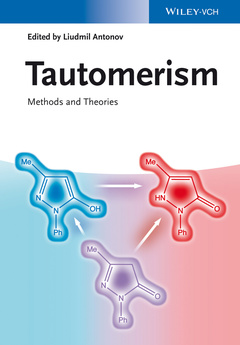Tautomerism Methods and Theories
Coordonnateur : Antonov Liudmil

The result is an introductory description providing suitable practical examples of the basic methods used to study tautomeric processes, as well as the theories describing the tautomerism and proton transfer phenomena. It also includes different spectroscopic methods for examining tautomerism, such as UV-VIs, time-resolved fluorescence spectroscopy, and NMR spectroscopy, plus the theoretical and practical background information.
With its excellent overview of the methods, theories and examples, this is the perfect guide for any scientist dealing with tautomeric compounds in a wider context.
TAUTOMERISM: INTRODUCTIN, HISTORY, AND RECENT DEVELOPMENTS IN EXPERIMENTAL AND THEORETICAL METHODS
The Definition and Scope of Tautomerism: Principles and Practicalities
Causes of Reversal in Tautomeric Form: Aromatic Resonance
Causes of Reversal in Tautomeric Form: Lone-Pair and Dipolar Repulsion
Causes of Reversal in Tautomeric Form: Selective Stabilization Through "Far" Intramolecular Hydrogen Bonding
Changes in Tautomeric Form Brought About by Electronegative Substituents
The Influence of Solvent on Tautomeric Form
Tautomeric Equilibrium: Historical Overview of an Analytical Problem
Short Historical Overview of Tautomerization Dynamics
Conclusions and Outlook
ABSORPTION UV-vis SPECTROSCOPY AND CHEMOMETRICS: FROM QUALITATIVE CONCLUSIONS TO QUANTITATIVE ANALYSIS
Introduction
Quantitative Analysis of Tautomeric Equilibria
Analysis of Real Tautomeric Systems
Concluding Remarks
STUDIES OF PHOTOINDUCED NH TAUTOMERISM BY STATIONARY AND TIME-RESOLVED FLUORESCENCE TECHNIQUES
Introduction
Photoinduced Proton/Hydrogen Atom Transfer
Fluorescence Techniques for Studying Tautomerism
Tautomerism in Bifunctional NH/N Azaaromatics
Ab initio and DFT Computational Methods
NH Tautomerism as a Tool in Biophysics
Concluding Remarks
FEMTOSECOND PUMP-PROBE SPECTROSCOPY OF PHOTOINDUCED TAUTOMERISM
Introduction
Ultrafast Pump-Probe Spectroscopy
Dynamics from Pump-Probe Spectroscopy
Reaction Mechanism
Reaction-Path-Specific Wavepacket Dynamics in Double ESIPT
Internal Conversion
Summary and Conclusions
NMR SPECTROSCOPY STUDY OF TAUTOMERISM IN SOLUTION AND IN THE SOLID STATE
Introduction
Methodologies of NMR Spectroscopy to Study Tautomerism
Types of Tautomerism Studied by NMR Spectroscopy
Conclusions and Outlook
ISOTOPE EFFECTS ON CHEMICAL SHIFTS AS A TOOL IN THE STUDY OF TAUTOMERIC EQUILIBRIA
Introduction
Experimental Requirements
Isotope Effects on Chemical Shifts
Secondary Equilibrium Isotope Effects on CS
Primary Isotope Effects
Solid State
Theoretical Calculations
Examples
Overview
TAUTOMER-SELECTIVE SPECTROSCOPY OF NUCLEOBASES, ISOLATED IN THE GAS PHASE
Introduction
Techniques
Guanine
Adenine
Cytosine
Uracil and Thymine
Base Pairs
Outlook
DIRECT EVIDENCE OF SOLID-STATE TAUTOMERISM BY DIFFRACTION METHODSD: ISOMERS, EQUILIBRIA, AND KINETICS
Application of X-Ray Diffraction to Study Tautomerism
Examples of X-Ray Diffraction Analysis of Proton Transfer
Other Diffraction Methods Used to Study Proton Transfer Reactions
DYNAMICS OF GROUND- AND EXCITED-STATE INTRAMOLECULAR PROTON TRANSFER REACTIONS
Introduction
Transition State Theory
Two Examples of Tautomerization
The Role of the Solvent
Solvent Friction and Solvent Dynamics
The Solvent Coordinate: Basics
Polarization Fluctuations
The Solvent Coordinate: An Application
Electronic Rearrangement
The Rug that Ties the (Classical) Room Together
Quantum and Classical
Quantum Decay
Coupling Quantum and Classical Motion: A Simple Example
Nonlinear Optics
Femtochemistry
Concluding Remarks
FORCE FIELD TREATMENT OF PROTON AND HYDROGEN TRANSFER IN MOLECULAR SYSTEMS
Introduction
Computational Approaches to Proton Transfer
Proton Transfer Reactions with MMPT
Applications of MMPT
Discussion and Outlook
THE SCOPE AND LIMITATIONS OF LSER IN THE STUDY OF TAUTOMER RATIO
Introduction
The Taft-Kamlet LSER Methodology
LSER Case Histories in the Field of Tautomerism
Overview
THE "BASICITY METHOD" FOR ESTIMATING TAUTOMER RATIO: A RADICAL RE-APPRAISAL
Introduction
Experimental Protocol
The Derivation of Correction Factors
Regularities Revealed by Correction Factors
Complicating Factors in the Use of the "Basicity Method"
Tautomeric Problems to Which the "Basicity Method" Is Inapplicable
Overview
QUANTUM CHEMICAL CALCULATION OF TAUTOMERIC EQUILIBRIA
Introduction
Computational Procedures
Solvent Effects
Applications of Quantum Chemical Methods to Tautomeric Equilibria
Concluding Remarks
Index
Date de parution : 01-2014
Ouvrage de 400 p.
17.7x25.2 cm
Thèmes de Tautomerism :
Mots-clés :
Tautomerism; Liudmil Antonov; Absorption UV-Vis spectroscopy and chemometrics; Application of NMR spectroscopy to tautomerism studies; isotope effects on chemical shifts as a tool in the study of tautomeric equilibria; the basicity method for the estimation of tautomer ratio; quantum chemical calculations of tautomeric equilibria force field treatment of proton and hydrogen transfer in molecular systems



